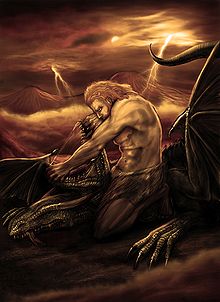Vahagn (or Vahagan) (Armenian: Վահագն) was a god in ancient history of Armenia. He was one of the Armenian Pantheon, together with Aramazd and Anahit.
Origin and Nature
Vahagn was associated with the Greek Heracles. The priests of Vahévahian temple claimed that Vahagn was their ancestor so they put his statue in their temple.
According to Euhemerist belief, all gods were living men. Vahagn came from the ranks of Armenian kings and he was the son of Yervand (6th century B.C.) and brother of Bab and Tiran.
Vahagn’s nature and origin was described in his birth song from ancient Armenia according to Khorenatsi, a historian:
- In travail were heaven and earth,
- In travail, too, the purple sea!
- The travail held in the sea the small red reed.
- Through the hollow of the stalk came forth smoke,
- Through the hollow of the stalk came forth flame,
- And out of the flame a youth ran!
- Fiery hair had he,
- Ay, too, he had flaming beard,
- And his eyes, they were as suns!
The missing part of the song is believed to relay how Vahagn fought and defeated dragons that made him known as Vishabakagh or "dragon reaper".
Vahagn was also referred to as a god of courage and sun-god, rival of Baal-shamin and Mihr.
Reference
- A History of Armenia by Vahan M. Kurkjian. Published by the Armenian General Benevolent Union of America 1958/YR.

